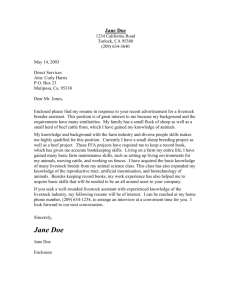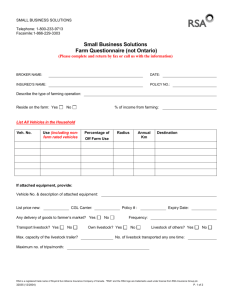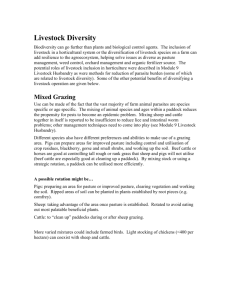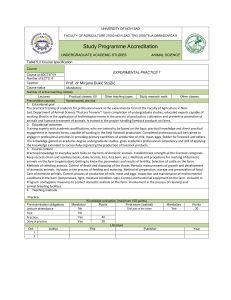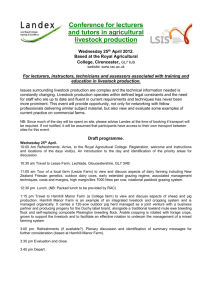Livestock on the Loose at an Accident Scene
advertisement
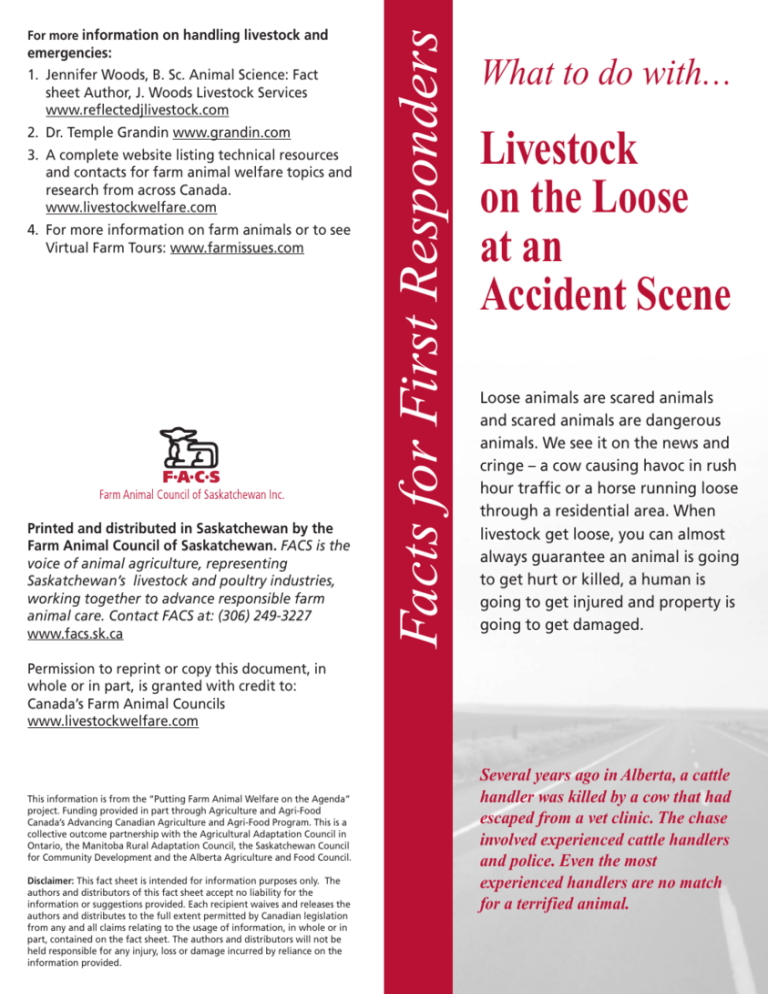
emergencies: 1. Jennifer Woods, B. Sc. Animal Science: Fact sheet Author, J. Woods Livestock Services www.reflectedjlivestock.com 2. Dr. Temple Grandin www.grandin.com 3. A complete website listing technical resources and contacts for farm animal welfare topics and research from across Canada. www.livestockwelfare.com 4. For more information on farm animals or to see Virtual Farm Tours: www.farmissues.com Printed and distributed in Saskatchewan by the Farm Animal Council of Saskatchewan. FACS is the voice of animal agriculture, representing Saskatchewan’s livestock and poultry industries, working together to advance responsible farm animal care. Contact FACS at: (306) 249-3227 www.facs.sk.ca Facts for First Responders For more information on handling livestock and What to do with… Livestock on the Loose at an Accident Scene Loose animals are scared animals and scared animals are dangerous animals. We see it on the news and cringe – a cow causing havoc in rush hour traffic or a horse running loose through a residential area. When livestock get loose, you can almost always guarantee an animal is going to get hurt or killed, a human is going to get injured and property is going to get damaged. Permission to reprint or copy this document, in whole or in part, is granted with credit to: Canada’s Farm Animal Councils www.livestockwelfare.com This information is from the “Putting Farm Animal Welfare on the Agenda” project. Funding provided in part through Agriculture and Agri-Food Canada’s Advancing Canadian Agriculture and Agri-Food Program. This is a collective outcome partnership with the Agricultural Adaptation Council in Ontario, the Manitoba Rural Adaptation Council, the Saskatchewan Council for Community Development and the Alberta Agriculture and Food Council. Disclaimer: This fact sheet is intended for information purposes only. The authors and distributors of this fact sheet accept no liability for the information or suggestions provided. Each recipient waives and releases the authors and distributes to the full extent permitted by Canadian legislation from any and all claims relating to the usage of information, in whole or in part, contained on the fact sheet. The authors and distributors will not be held responsible for any injury, loss or damage incurred by reliance on the information provided. Several years ago in Alberta, a cattle handler was killed by a cow that had escaped from a vet clinic. The chase involved experienced cattle handlers and police. Even the most experienced handlers are no match for a terrified animal. Tips & Hints Things you need to know about… 1. These animals are extremely dangerous. Public safety must always take priority over anything else. If an animal is a threat to the public, it must be euthanized as soon as you can safely do so. 2. Do not chase the animals, on foot or in a car or truck. Never yell or use a horn or sirens. This makes you more of a predator and will only make the animal more frightened. 3. Livestock are prey animals and are programmed to flee when frightened. If they become cornered and feel threatened, they will attack until they are able to flee. 4. If the animal is standing calmly in one place or grazing, do not approach. Keep everyone away from the animal until a plan is established and a containment area can be created or found. 5. If the animal is standing along a fence line or corral near other animals, it just wants back in with its herd mates. Open the gate or find a way for the animal to get back in. 6. When approaching livestock try to avoid approaching them head on or directly from behind (they cannot see you). Approach from the side, around the area of their hip. 7. If you do have to move livestock, move them in a group very slowly and calmly. Pavement is very slippery for hoofed animals. 8. Do not enlist the help of bystanders and keep all people (including the media) away from the animals, ideally out of the area completely. If assistance is required, bring in handlers you are familiar with. 9. Find an area nearby or materials to contain the animals. You should aim to have containment options prearranged before you need it. Gates, snow fences for smaller animals, a feed store supplier, salesbarn, or fair ground, or even creative options in emergencies such as a fenced tennis court or carwash bay. Your goal is to find materials and areas that are safe for both animals and humans! 10. Access to a livestock truck or trailer will be required to transport the animal(s) once it is contained. Once animals are contained, allow them to calm down and then quietly load them into a livestock trailer. 11. Sedation should be used as a last resort as it can be extremely dangerous and is not always effective. It is extremely risky to the health and safety of animals and personnel. Only trained professionals can perform this task. 12. Ensure you have someone on your department or access to someone that is trained to euthanize an animal with a firearm if necessary. Cattle: • Bulls (mature males) and bison are extremely aggressive and can be very dangerous animals. When public safety is at risk, consider euthanizing these animals immediately. • Cattle have extreme reach with their back legs and can strike behind them, off to their side and up by their head. They can also kick out to the side while running. Horses: • Horses can strike with both their back feet and their front feet. They will also bite. • Try to approach a horse on its left side while avoiding eye contact, which threatens the horse. Pigs: • Be careful when handling pigs, as they can bite you. Boars (adult males) can be very aggressive. • Do not run pigs, as this may kill them. • Pigs are difficult animals to move, even when they are not scared! They will make loud squealing noises that sound like they are in pain even when they are not. Poultry: (chickens, turkeys, ducks) • Poultry frighten quickly when in close contact with people and will react hysterically. It makes them difficult to contain and handle. Try not to startle them. • The best containment and herding aid for poultry is snow or construction fence. Sheep: • Do not grab sheep by their wool. • Sheep pile up when frightened. If they pile up, you will need to back off and allow them to calm down. • Sheep will do anything to stay with the group. Don’t isolate any sheep, move them as a group. Top 5 things you need to know about livestock in an emergency 1. Livestock do not understand lights and sirens mean pullover. This will definitely not make them stop. 2. When an animal feels cornered, it will fight or try to run. 3. Livestock view us as predators and their natural instinct is to flee from predators. 4. Prey animals are herd animals and become extremely agitated when isolated or separated from other animals. Single animals are extremely dangerous animals. 5. Once livestock are excited or scared it will take at least 20 to 30 minutes to calm them back down.
